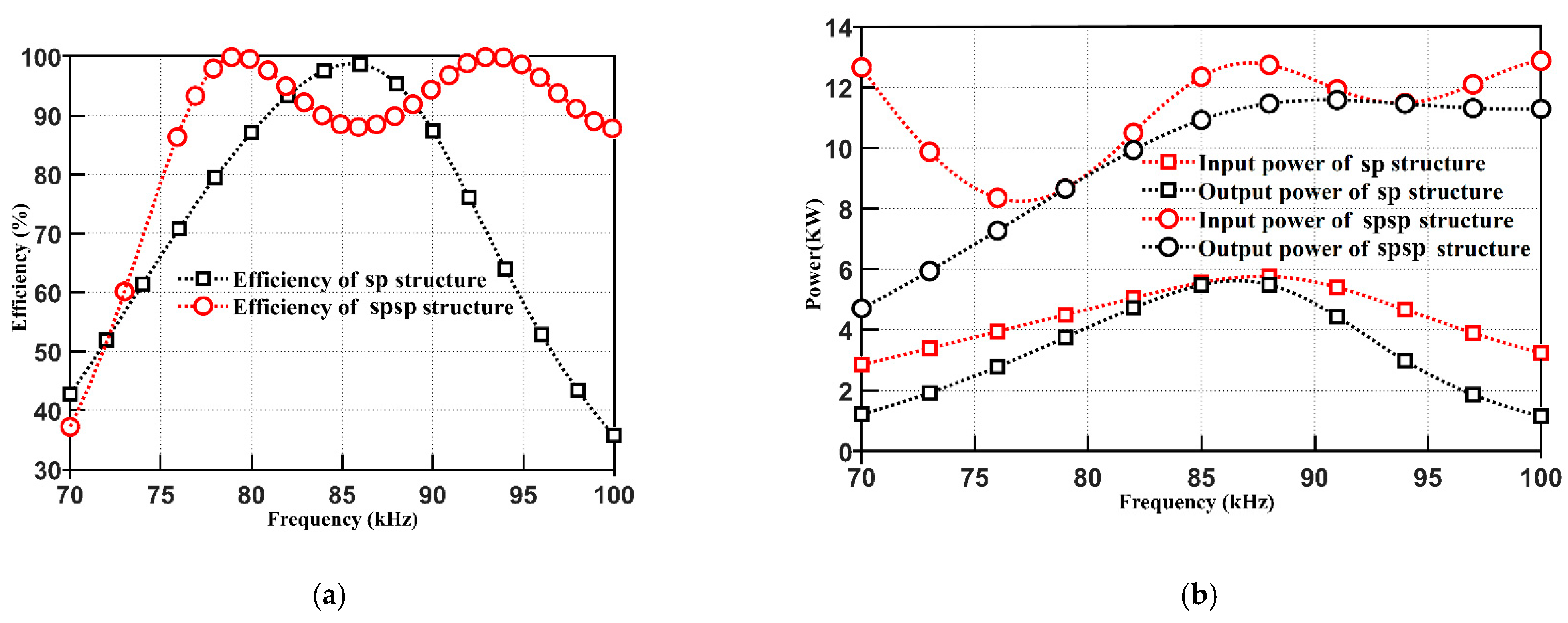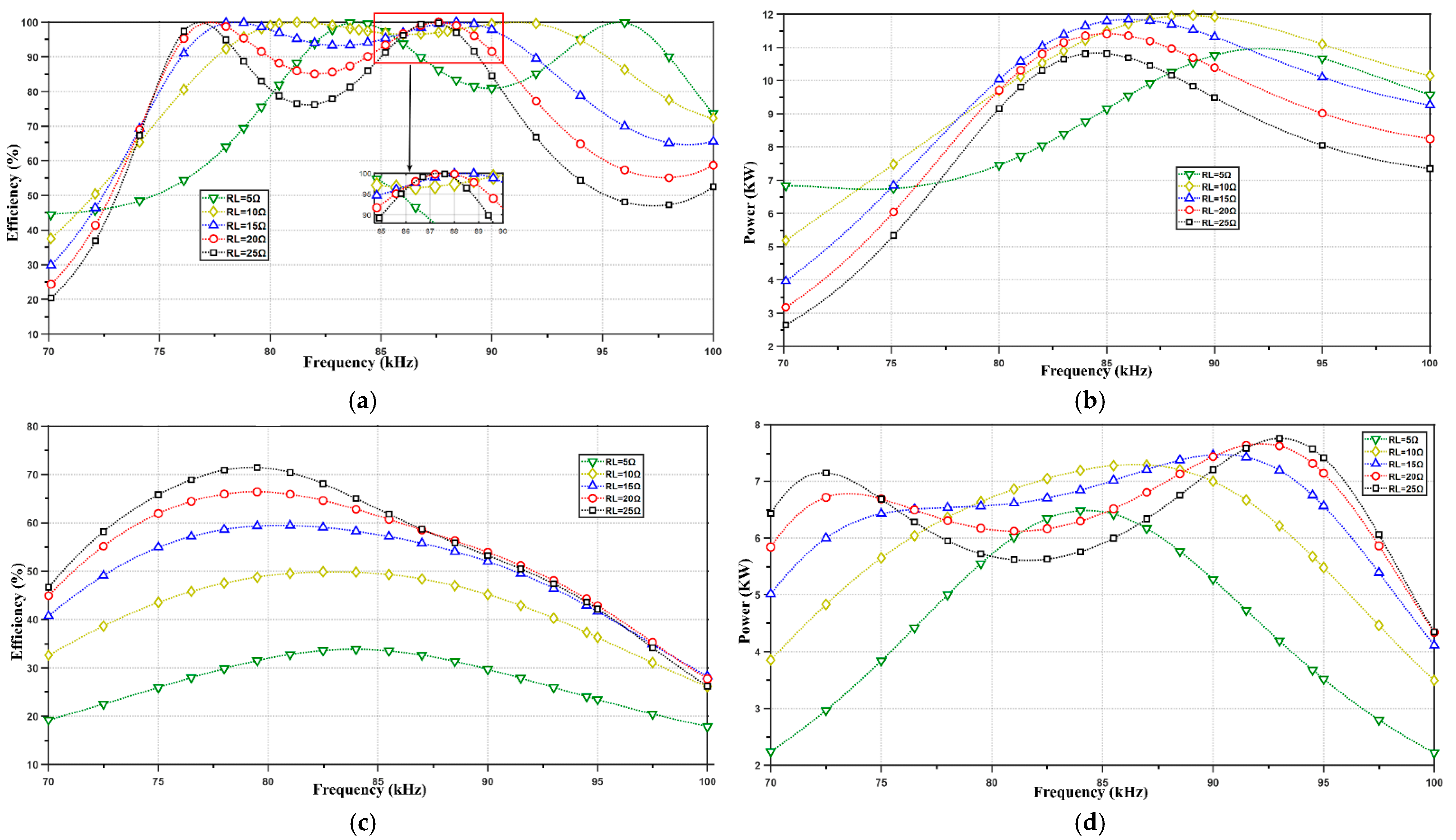Study and Optimization of Transmission Characteristics of the Magnetically Coupled Resonant Wireless Transmission System
Abstract
:1. Introduction
2. Fundamentals
3. Analysis of Magnetically Coupled Resonant Transmission Structures
3.1. Modelling of SPSP Magnetically Coupled Resonant Structures
3.2. Modelling of SP Magnetically Coupled Resonant Structures
4. Research and Analysis of Magnetically Coupled Resonant Systems
4.1. Frequency Characteristics Study
4.2. Characterization of the Coupling Coefficient
4.3. Load Resistance Characteristics Study
5. Multi-Objective Parameter Optimization of Systems Based on the Improved Grey Wolf Optimization Algorithm
5.1. Grey Wolf Optimization Algorithm Model
5.2. Ideas for Improving the Grey Wolf Optimization Algorithm Model
5.3. Improving the Grey Wolf Algorithm for Multi-Objective Parameter Optimization
5.3.1. Optimal Constraints
5.3.2. Adaptation Function
5.4. Optimization Simulation of Magnetically Coupled Resonant Systems
6. Experimental Validation
6.1. System Coil Structure Simulation Experiments
6.2. Experiments with Offset Distances between Coils
7. Conclusions
8. Patents
Author Contributions
Funding
Data Availability Statement
Acknowledgments
Conflicts of Interest
References
- Kurs, A.; Karalis, A.; Moffatt, R.; Joannopoulos, J.D.; Fisher, P.; Soljacic, M. Wireless power transfer via strongly coupled magnetic resonances. Science 2007, 317, 83–86. [Google Scholar] [CrossRef] [PubMed] [Green Version]
- Karalis, A.; Joannopoulos, J.D.; Soljačić, M. Efficient wireless non-radiative mid-range energy transfer. Ann. Phys. 2008, 323, 34–48. [Google Scholar] [CrossRef] [Green Version]
- Liu, Z.; Chen, Z.; Peng, C.; Liang, J.; Xiao, P.; Bian, L.; Qiu, Y.; Li, G. A misalignment resilient system for magnetically coupled resonant wireless power transfer. IEEE Trans. Antenn. Propag. 2020, 68, 8260–8265. [Google Scholar] [CrossRef]
- Liu, Z.; Chen, Z.; Li, J.; Zhao, H. A shape-reconfigurable modularized wireless power transfer array system for multipurpose wireless charging applications. IEEE Trans. Antenn. Propag. 2018, 66, 4252–4259. [Google Scholar] [CrossRef]
- Sagar, M.; Islam, S.; Ouassal, H.; Omi, A.I.; Wisniewska, A.; Jalajamony, H.M.; Fernandez, R.E.; Sekhar, P.K. Application of Machine Learning in Electromagnetics: Mini-Review. Electronics 2021, 10, 2752. [Google Scholar] [CrossRef]
- Lu, C.; Huang, X.; Tao, X.; Liu, X.; Rong, C.; Zeng, Y.; Liu, M. Design and analysis of an omnidirectional dual-band wireless power transfer system. IEEE Trans. Antenn. Propag. 2020, 69, 3493–3502. [Google Scholar] [CrossRef]
- Cheng, C.; Zhou, Z.; Li, W.; Zhu, C.; Deng, Z.; Mi, C.C. A multi-load wireless power transfer system with series-parallel-series compensation. IEEE Trans. Power Electr. 2019, 34, 7126–7130. [Google Scholar] [CrossRef]
- Fu, M.; Yin, H.; Liu, M.; Wang, Y.; Ma, C. A 6.78 MHz multiple-receiver wireless power transfer system with constant output voltage and optimum efficiency. IEEE Trans. Power Electr. 2017, 33, 5330–5340. [Google Scholar] [CrossRef]
- Zhang, Z.; Pang, H.; Georgiadis, A.; Cecati, C. Wireless power transfer—An overview. IEEE Trans. Ind. Electr. 2018, 66, 1044–1058. [Google Scholar] [CrossRef]
- Zheng, Z.; Wang, N.; Ahmed, S. Adaptive Frequency Tracking Control with Fuzzy PI Compound Controller for Magnetically Coupled Resonant Wireless Power Transfer. Int. J. Fuzzy Syst. 2021, 23, 1890–1903. [Google Scholar] [CrossRef]
- Peng, C.; Chen, Z.; Liu, Z.; Wang, J.F.; Liang, J.; Li, C.; Tao, S.; Li, J. On the Load-Independence of a Multi-Receiver Wireless Power Transfer System. IEEE Microw. Wirel. Compon. Lett. 2019, 29, 563–565. [Google Scholar] [CrossRef]
- Monti, G.; Tarricone, L.; Dionigi, M.; Mongiardo, M. Magnetically coupled resonant wireless power transmission: An artificial transmission line approach. In Proceedings of the 2012 42nd European Microwave Conference, Amsterdam, The Netherlands, 29 October–1 November 2012; pp. 233–236. [Google Scholar]
- Yan, R.; Ma, W.; Yang, Q.; Zhang, X. Out-of-step optimization of magnetically coupled resonant wireless power transmission system. Chin. J. Electr. Eng. 2022, 1–10. [Google Scholar]
- Yang, J.; Chen, W. Output Control of Wireless Power Transfer System Based on Improved Artificial Bee Colony Algorithm. J. Power Supply 2021, 20, 173–182. [Google Scholar]
- Zhang, Y.; Wang, L.; Guo, Y.; Tao, C. Multi-Objective Optimization of Magnetic Coupler for Wireless Power Transfer System Based on NSGA-II Algorithm. Adv. Technol. Electr. Eng. Energy 2020, 39, 28–34. [Google Scholar]
- Wu, Z.; Yan, R.; Guo, X.; Cao, S. Analysis of Transmission Distance and Efficiency of Wireless Power Transfer System. Chin. J. Power Source 2020, 44, 1212–1216. [Google Scholar]
- Cui, S.; Song, B.; Wang, Z. Overview of Magnetic Coupler for Electric Vehicles Dynamic Wireless Charging. Trans. China Electrotech. Soc. 2022, 37, 537–554. [Google Scholar]
- Ni, C.; Chen, H.; Li, D.; Zhou, C. Structural Optimization of Tapered Resonant Coil in Magnetically Coupled Resonant Wireless Power Transfer System. J. Sichuan Univ. 2020, 57, 304–310. [Google Scholar]
- Zhang, Z.; Liu, J.; Li, Y. Design and Analysis of a Multi-Input Multi-Output System for High Power Based on Improved Magnetic Coupling Structure. Energies 2022, 15, 1684. [Google Scholar] [CrossRef]
- Nakamura, S.; Baba, K.; Miyaura, T. Automatic Resonance Compensation for Efficient WPT via Magnetic Resonance Coupling Using Flexible Coils. Energies 2021, 14, 5254. [Google Scholar] [CrossRef]
- Bilandžija, D.; Vinko, D.; Barukčić, M. Genetic-Algorithm-Based Optimization of a 3D Transmitting Coil Design with a Homogeneous Magnetic Field Distribution in a WPT System. Energies 2022, 15, 1381. [Google Scholar] [CrossRef]
- Jawad, A.M.; Nordin, R.; Jawad, H.M.; Gharghan, S.K.; Abu-Samah, A.; Abu-Alshaeer, M.J.; Abdullah, N.F. Wireless Drone Charging Station Using Class-E Power Amplifier in Vertical Alignment and Lateral Misalignment Conditions. Energies 2022, 15, 1298. [Google Scholar] [CrossRef]
- Feng, G.; Liu, Z.; Hou, Y.; Luo, X.; Sun, S.; Ding, R.; Yu, A. Parameter Optimization of Double LCC MCRWPT System Based on ZVS. Energies 2021, 14, 5309. [Google Scholar] [CrossRef]
- Sato, S.; Nakamura, S. Proposal of Wireless Charging Which Enables Magnetic Field Suppression at Foreign Object Location. Energies 2022, 15, 1028. [Google Scholar] [CrossRef]
- Mirjalili, S.; Mirjalili, S.M.; Lewis, A. Grey Wolf Optimizer. Adv. Eng. Softw. 2014, 69, 46–61. [Google Scholar] [CrossRef] [Green Version]
- Mirjalili, S.; Saremi, S.; Mirjalili, S.M.; Coelho, L.d.S. Multi-Objective Grey Wolf Optimizer: A Novel Algorithm for Multi-Criterion Optimization. Expert Syst. Appl. 2016, 47, 106–119. [Google Scholar]
- Hu, P.; Pan, J.-S.; Chu, S.-C. Improved Binary Grey Wolf Optimizer and Its Application for Feature Selection. Knowl.-Based Syst. 2020, 195, 105746. [Google Scholar] [CrossRef]












| (V) | () | () | () | () | () | |
| 220 | 0.35 | 10 | 1 | 1.96 | 33.3 | 0.02 |
| () | () | () | () | () | () | () |
| 218 | 2.2 | 27 | 20.8 | 3.33 | 10 | 3 |
| System Architecture | Parameter Conditions | Optimization Conditions | |
|---|---|---|---|
| before Optimization | after Optimization | ||
| spsp magnetically coupled resonant system | Population size | 30 | \ |
| Iteration | 20 | \ | |
| Load resistance | 10 | 12 | |
| Frequency | 70–100 kHz | 80 kHz | |
| Coupling factor | 0.35 | 0.33447 | |
| Efficiency | 60–78% | 90.53% | |
| Parameters | Value/Model | Parameters | Value/Model | Parameters | Value/Model |
|---|---|---|---|---|---|
| Digital Oscilloscopes | SDS1102X-E | 12 | 10.4 | ||
| DC | MN-3205D | 2.2 | 3 | ||
| Signal generators | SDG1025 | 33 | Coupling factor | 0.33 | |
| Spectrum Analyzer | GA40XX | 220 | Resonant frequency | 80 kHz | |
| Voltage regulator modules | LM2596 | 2.2 | 1 | ||
| Power amplifiers | LM1875 | 27 | 22 | ||
| Load | Light source load | Digital frequency meters | OPA615 | 3.3 |
Publisher’s Note: MDPI stays neutral with regard to jurisdictional claims in published maps and institutional affiliations. |
© 2022 by the authors. Licensee MDPI, Basel, Switzerland. This article is an open access article distributed under the terms and conditions of the Creative Commons Attribution (CC BY) license (https://creativecommons.org/licenses/by/4.0/).
Share and Cite
Wen, C.; Chen, M.; Xu, Q. Study and Optimization of Transmission Characteristics of the Magnetically Coupled Resonant Wireless Transmission System. Electronics 2022, 11, 1940. https://doi.org/10.3390/electronics11131940
Wen C, Chen M, Xu Q. Study and Optimization of Transmission Characteristics of the Magnetically Coupled Resonant Wireless Transmission System. Electronics. 2022; 11(13):1940. https://doi.org/10.3390/electronics11131940
Chicago/Turabian StyleWen, Chunming, Minbo Chen, and Qing Xu. 2022. "Study and Optimization of Transmission Characteristics of the Magnetically Coupled Resonant Wireless Transmission System" Electronics 11, no. 13: 1940. https://doi.org/10.3390/electronics11131940







